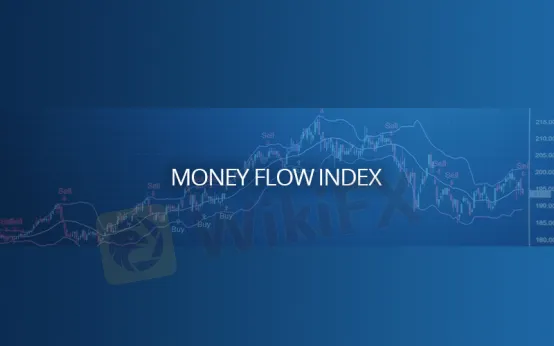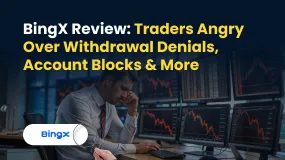简体中文
繁體中文
English
Pусский
日本語
ภาษาไทย
Tiếng Việt
Bahasa Indonesia
Español
हिन्दी
Filippiiniläinen
Français
Deutsch
Português
Türkçe
한국어
العربية
How to Use the Money Flow Index Indicator to Make Money in Forex
Abstract:The money flow index indicator is a sophisticated technical indicator that can be found in most Forex trading systems for free. For an easy-to-read visual depiction of momentum, it is plotted immediately on a price chart. A good Forex trading strategy may be built on trading with high market momentum. In this post, I've taken a deeper look at the money flow index indication to help you determine whether you should use it in your trading as you strive to become a more lucrative Forex trader.

The money flow index indicator is a sophisticated technical indicator that can be found in most Forex trading systems for free. For an easy-to-read visual depiction of momentum, it is plotted immediately on a price chart. A good Forex trading strategy may be built on trading with high market momentum. In this post, I've taken a deeper look at the money flow index indication to help you determine whether you should use it in your trading as you strive to become a more lucrative Forex trader.
What is the Money Flow Index Indicator, and how does it work?
The money flow index indicator (MFI) is a single numerical output oscillator and momentum indicator that ranges from 0 to 100. 100 is the maximum bullish (upwards) momentum value, whereas 0 represents the highest bearish (downwards) momentum number.
The MFI is frequently referred to as a volume-weighted Relative Strength Index. The MFI's exact computation will be discussed later in this text. It determines the intensity of momentum at any particular time by combining price and volume, two of the most definite aspects of technical analysis. The MFI is commonly used by forex traders to spot positive and negative divergences between the indicator value and price movement, as well as to fade (trade a reversal) overbought (above 80) or oversold (below 20) levels.
However, in Forex, buying or selling only based on the value of an indicator applied to a particular time frame is a money flow index technique that I do not suggest since it is never lucrative in the long run. The MFI is better utilized in more advanced methods, which I'll discuss later in this essay.
Because the MFI relies on volume and the Forex market is decentralized, precise volume data is usually difficult to come by. Forex traders will find it more difficult to use the MFI than equities traders, who have access to clear volume data. Some Forex firms are now offering real-time volume data, although this data only includes the broker's internal flow or volume data from their liquidity providers, and does not represent the whole market.
To compute the volume element, money flow index indicators integrated into or added as plugins to the MetaTrader 4 or MetaTrader 5 trading platforms employ tick volume. Because a few Forex companies provide their own volume data, certain versions of the MFI indicator that use the broker's data can be found, however these can be difficult to discover. Volume data is available for currency pair futures traded over the counter on major US exchanges, which is a third alternative that is not widely addressed. This allows you to use the MFI indicator with data from currency futures while trading the spot Forex equivalent of the MFI indicator data supplied by the relevant currency future. Although futures are only accessible on a restricted number of currency pairings, principally the majors, this can work well if you can set it up.

How to Use the Money Flow Index Indicator (MFI)
I will start by discussing the three types of trading signals the MFI can generate. Before using any technical indicator, I always stress the importance of understanding what indicators can tell traders about price action. Many new traders rush into using indicators without knowing how to apply them effectively. They rely on the simplest principles, which I want to note again, do not generate consistent profits. Otherwise, the retail loss rate of Forex traders would not range between 70% and 85% at most major Forex brokerages.
Here are the three types of trading signals that MFI provides:
1. Oversold and Overbought Levels: When the MFI moves below 20, traders consider the asset oversold. An overbought condition occurs with the MFI above 80. They are the most direct trading signals from the MFI but also the least reliable. Shorter time frames, for example, the M5 or M15 charts, will get more readings below 20 and above 80. The drawback remains reduced reliability. I prefer the MFI on the H1 chart, a middle ground between frequency and accuracy. Some traders wait for the MFI to break out or break down above and below 20 and 80 before entering a trend, as it may suggest the correction or sell-off is near the end, with volume flowing into the asset for a trend reversal.
2. Positive and Negative Divergences: I prefer to trade divergences because, in my opinion, they produce the most dependable trading signals. When price action makes a lower low while the MFI or another indicator makes a higher low, this is known as a positive divergence. When price action makes a higher high while the indicator makes a lower high, a negative divergence occurs. Failure swings, the MFI's third trading signal, provide confirmation for positive and negative divergences.
3. Bullish and Bearish Failure Swings: While positive and negative divergences are still good trading signals, I like to double-check them with bullish and bearish failure swings. You'll miss out on some of the pricing activity, but your dependability will improve significantly. When the MFI drops below 20, then reverses above it, corrects from its peak but maintains above 20, and then accelerates to a higher high, it is considered a bullish failure swing. After the MFI advances above 80, it slips below it before rising but sustaining its position below 80 before crashing to a lower low.
The Money Flow Index Indicator and How to Calculate It (MFI)
The money flow index indicator is calculated automatically by the MT4 and MT5 trading platforms. Despite this, I usually advise traders to grasp how the computations operate in order to have a better understanding of the MFI. Traders that know how to manually plot the MFI, including the calculations, will have a higher success rate when employing it.
1. Calculate the typical price by adding the high, low, and close. Then divide it by three.
2. Calculate the money flow by multiplying the typical price by volume. If the current price is above the previous one, it is known as positive money flow. If the current price is below the previous one, it is known as negative money flow.
3. Calculate the money flow ratio by dividing the 14-period positive money flow by the 14-period negative money flow. Positive money flow is the sum of positive money over the past fourteen days, and negative money flow is the sum of negative money.
4. Calculate the money flow index indicator using the formula: 100 - 100/ (1 + money flow ratio).
The MFI can provide solid trading indications, but it is not a holy grail for traders. Positive and negative divergence signals, validated by bullish and bearish failure swings, are the greatest way to develop trade entry ideas. I also recommend combining the MFI with at least one other indication and at least one other time period, with the lower time frame being no lower than the hourly (H1).

Disclaimer:
The views in this article only represent the author's personal views, and do not constitute investment advice on this platform. This platform does not guarantee the accuracy, completeness and timeliness of the information in the article, and will not be liable for any loss caused by the use of or reliance on the information in the article.
Read more

BingX Review: Traders Angry Over Withdrawal Denials, Account Blocks & More
Are BingX officials with you when you lose your trade? Do these officials apply restrictions on withdrawals as you earn profits? Do you lose access to BingX com login after earning profits? Does the US-based forex broker block your trading account in such situations? Failing to get key trading data access from the broker? These issues have been affecting many traders at BingX. In this BingX review article, we have shared some complaints. Take a look!

Uniglobe Markets India Review 2025: A Complete Guide to Safety, Costs, and Features
Started in 2014, Uniglobe Markets, a forex and CFD broker, has become known in the Indian trading community. The company offers different types of accounts, access to popular trading software, and high leverage options. However, every trader's main concern should be whether their money is safe and if the broker is legitimate. This article gives you a detailed and factual look at Uniglobe Markets, focusing on its services, trading conditions, and most importantly, how safe it is. To answer the main question about legitimacy right away: Uniglobe Markets operates without any valid financial regulation. This one fact is the most important thing to know about our entire review, as it has serious consequences for trader safety. Our goal is to break down all the available information to help you make a smart decision.

Uniglobe Markets Bonus Review: Understanding the Offers and Uncovering the Risks
Many traders start looking for a new broker by searching for special deals and bonuses. The phrase "Uniglobe Markets no deposit bonus" is something people often search for. Let's address this question clearly and directly. Based on all the information we have, Uniglobe Markets does not currently offer a no-deposit bonus. Instead, this broker focuses on bonuses that require you to deposit your own money first. To get any bonus credits, traders must put in their own capital. Read on to learn how this entire bonus works out for traders.

PINAKINE Broker India Review 2025: A Complete Guide to Safety and Services
As online trading grows in popularity, Indian traders are always looking for brokers that offer good deals and fair conditions. PINAKINE has become one of these companies, getting attention by promising high leverage and many different account options. This broker, officially called Pinakine Liquidity Limited, has been operating for about one to two years and has made many people curious. Traders want to know the answer to the most important question: Is PINAKINE a real and safe place to invest money, or are there hidden dangers behind its attractive offers? Read on to know the answer.
WikiFX Broker
Latest News
Voices of the Golden Insight Award Jury | Tim Waterer, Chief Market Analyst of KCM Trade
Stonefort Securities Review: A Fair Look at Safety, Rules, and What Traders Say
Trump asks for meat packer probe over beef prices
Prop Firm Scams: When ‘Getting Funded’ Costs You Everything
PINAKINE Broker Review: A Complete Look at Its Services and Risks
One-Click Access to Broker Official Group Chats & Exclusive VPS Benefits
Consumer sentiment nears lowest level ever as worries build over shutdown
Uniglobe Markets MT4 Review: A Complete Look at Features, Costs, and Important Safety Issues
Is PINAKINE Broker Safe or a Scam? A 2025 Complete Review
Easy Money Doesn't Exist! High-Return Promise Turned into an RM44,000 Scam
Currency Calculator




